#there's the inherent shame of being a woman a bit more sexually liberated than most>they had sex before marriage and she was probably
Explore tagged Tumblr posts
Text
CAN YOU BELIEVE THAT THE GUY WHO HAS TREATED ADA THE BEST UP UNTIL NOW WAS FUCKING- ugh. Give me a second. *swallows a bit of vomit* ok ok. I'm good. no wait- blegh. ok. ahem. FUCKING MONTRESOR?????????
#nevermore webtoon#ada nevermore#montresor nevermore#nu but fr her back story makes so much sense for her behavior (and i called it like five years ago but whatever)#she wants to be a lady>if she was a lady maybe he would have taken her seriously and maybe even married her#and also#there's the inherent shame of being a woman a bit more sexually liberated than most>they had sex before marriage and she was probably#pregnant too#she can't accept rejection>that motherfucker made her believe that insults and distance were a form of love#she needs like 3 nice words to fall in love with someone>i don't think that guy knows what nice MEANS#she will never know that she's bisexual>women are too hot and nice!!!!! what is she supposed to do with that!!!!!!!#anyway#her backstory is hitting HARD#probs bc it's one of the more realistic ones :/#nev
121 notes
·
View notes
Text
Putting the “Camp” Back in “Conversion Camp”
How But I’m a Cheerleader (2000) Makes a Comedy Out Of Conversion Therapy (And Whether or Not it Should)

Jamie Babbit’s cult classic, But I’m a Cheerleader (2000) paints a satirical portrait of what most queer youth fear most, conversion therapy. The titular cheerleader, Megan (Natasha Lyonne) is your typical all-American good girl. She goes to church, she never drinks, and she is even dating the high school football star. She is the kind of daughter that white, middle-class Americans dream of having, with one glaring exception. Megan is a lesbian. With the help of the self proclaimed “ex-gay” counselor Mike (RuPaul), her family and friends stage an intervention before shoving her off to True Directions, a conversion camp run by Mary Brown (Cathy Moriarty). Once there, she realizes that she is in fact a lesbian, one who is in love with her fellow camper, Graham (Clea Duvall).
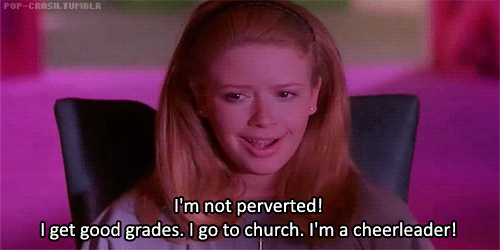
The film is hilariously over the top, hence it’s description as a camp classic. Babbit uses exaggerated gender roles to illustrate the intersection between gender performativity and sexuality. Unfortunately this decision to poke fun at heteronormative stereotypes come at a cost. Even the gay characters are uncomfortable stereotypes, and the film ignores any questions of intersectionality. Moreover, Babbit does not always handle the horrors of conversion therapy with the kind of tact and grace such a subject demands. Essentially, while the film attempts to show the ridiculousness of gay conversion, its use of stereotypes and one-dimensional characters lashes back to harm the very people Babbit is speaking on behalf of.
One of the most easily recognizable problems with But I’m a Cheerleader is its overwhelming whiteness. There are all of four characters of color, and only one of those characters is a woman. Jan (Katrina Philips), the one woman of color, is treated terribly in the film. She shows up with a unibrow, dark mustache, shaved head, and baggy clothes. When she introduces herself, she smiles and says, “I’m Jan, and I’m a softball player, and I’m a homosexual” (00:14:36). Essentially, Jan is a lot of outdated stereotypes about lesbians put into one character. The twist, though, is that Jan is actually straight.
youtube
This is a good example of how Babbit attempts to tell an important message, but she fails to see the harm she causes while doing it. Jan’s character is essentially Megan’s foil. She is everything a “dyke” is supposed to be, except that she is not attracted to girls. Megan, on the other hand is a lesbian that completely defies all of the stereotypes that Jan encompasses. Both women are meant to discourage our tendency to make assumptions based on appearance. While that is a wonderful message, the problem is that Jan is the only woman of color. There is a definite lack of positive representation for masculine women of color, so there is nothing inherently wrong with having a black, butch character. However, black women are often portrayed as more masculine than white women in both fiction and non-fiction. One need only look at the conversations the media has had about Serena Williams or the New Jersey Four to see how black women are ascribed a level of masculinity that white women are not. In the film, this is exacerbated by the consistent assertion that Jan is ugly, which is never challenged by any of the characters. The motive behind Jan’s character was excellent, but it is clear that the consequences were not thought out. Babbit could have avoided the problematic elements of her character by adding in more women of color, giving the masculine stereotypes to a white character, or by having a conversation about how her blackness and dark facial hair affected how she was treated. Instead, the meaning of Jan’s character is one-dimensional, and she comes off as the butt of the joke rather than the harbinger of an important message.
Jan is not the only character wrought with gay stereotypes. Andre (Douglas Spain) is the most stereotypically gay man in the film. Whether by coincidence or not, he is also a person of color. Regardless, his character is so stereotypical it is almost offensive. The boys are taught to play football, chop wood, and fix cars in the hopes that heteronormative activities will straighten them out, so to speak. Andre fails miserably at all of these tasks, which, again, is fine in concept. What is offensive is the way he flails about and shrieks in a way that is so unnatural it plays out like a bigot’s idea of what a gay man is really like.
youtube
There are other issues of intersectionality and representation that are not quite so garishly offensive. For example, Joel (Joel Michaely) is Jewish, and very devoutly so considering he is never seen with his yarmulke. The True Directions programs, however, is very Christian-oriented. This tension between the two religions is never addressed, and that is truly a shame. Moreover, race is not mentioned once. As previously mentioned, there are horrendously few characters of color. Even worse, however, is the fact that not one of them has a storyline that acknowledges the difficulties of being a gay person of color. The film is a comedy, so no one should expect an especially fruitful in depth analysis, but there is not even one or two off handed jokes about it. The fact of the matter is that the characters of color are not fully realized people. They are surface level representations that rattle off jokes. It should be acknowledged that pretty much all of the characters have this shallow level of development (such is the price one pays when creating a satire that makes such liberal use of stereotypes), but that is no excuse for not acknowledging how race plays a factor in homophobia and gender norms. Much of the movie is centered around learning how to “act straight”, but performances of gender and sexuality shift when different identities come into play. Harris and Holman Jones explain how intersectional performances play into feeling like a minority, “In “feeling queer,” racialized subjects intersect with religious, gendered and sexualized minoritarian subjects to “do” minoritarianism differently” (Harris and Holman Jones, 2017, p.574). In a film that is all about acting out the roles society demands, ignoring how people of color are expected to perform their minoriatarianism does an injustice to the topic at hand.
There is also a good bit of homonormativity, a concept that describes the push for queer people to fulfill heteronormative roles even in gay relationships. The three same sex couples we see in the film follow the general idea that one person in the relationship should be more feminine and the other more masculine, though some couples embody this concept more than others. Dolph (Dante Basco) and Clayton (Kip Pardue) are the couple that fit this mold the least, but one there are remnants of it in their relationship. Dolph is on the varsity football team, and Clayton is generally more demure and submissive. Unlike Dolph and Clayton, Graham and Megan fulfill their homonormative roles with a good amount of clarity. Graham is by no means butch, but she is more masculine than she is feminine, at least by society’s standards. She has short hair, she never wears skirts, and she has a tendency toward profanity and vulgarity. Megan, on the other hand, is, well, a cheerleader. She only wears skirts, she wears her hair long, and she spends most of the moving gasping at any mention of sex. Finally, there is the old gay couple, Lloyd (Wesley Mann) and Larry (Richard Moll) who are “ex-ex-gays” as the film calls them. Once again we see the more feminine half of the couple, Lloyd, performing typically feminine activities like setting up dinner and getting in touch with his emotions. Larry, on the other hand, is a curt, large, bearded man who is quick to anger. The two could easily fit in to any heterosexual sitcom.

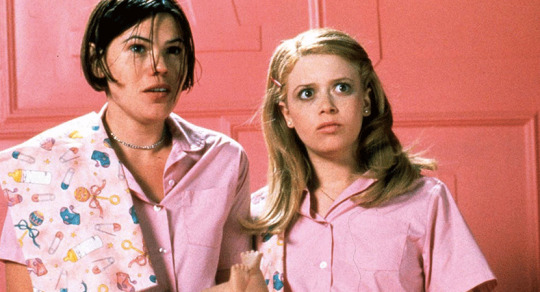
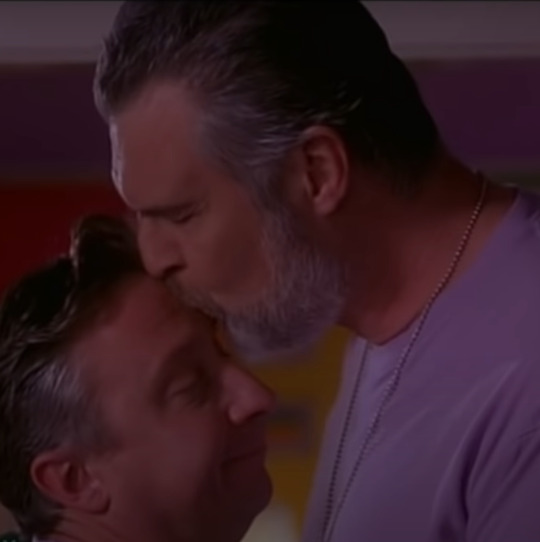
While domesticity is the goal for many queer couples, the film ventures into what Duggan (2002) calls, “equality politics,” (p. 44). Essentially, it is the trap that members of the gay community where they ask the powers that be for marriage and military equality. After that, they feel that there is nothing left to do, so they promise to depoliticize gay culture. Duggan describes them best when she writes, “These organizations, activists, and writers, promote ‘color-blind’ anti-affirmative action racial politics, conservative-libertarian ‘equality feminism,’ and gay ‘normality,’” (Duggan, 2002, p. 44). In it’s failure to acknowledge race and the enforcement of heterosexual roles onto gay characters, the film certainly demonstrates these equality politics and a message in favor of homonormativity.
Perhaps the most difficult to address issue with the film is the premise itself. It begs the question: should conversion therapy be used for comedy? Moreover, questions of how to do that respectfully arise, and, frankly, there were several instances where Babbit failed to do so. Babbit’s own history is important in understanding why she created a comedy about conversion therapy. She herself is a lesbian, and her mother worked at New Directions, a rehabilitation center for teens and young adults. Obviously, the name of the conversion camp, true directions, is a play on New Directions, and Babbit further explains the connection between her mother's career and But I’m a Cheerleader in an interview with Wheeler Winston Dixon. “So I'd always wanted to do a comedy about growing up in rehab, and the absurdity of that atmosphere. But I didn't want to make fun of twelve-step programs for alcoholism and drugs, because they really help people, but when you turn it into Homosexuals Anonymous, then I felt that was a situation I could have fun with” (Dixon, 2015, p. 2). Babbit likely felt that conversion therapy would be a harmless target because making fun of the programs and their leaders is not damaging to anyone. However, as we have seen with Jan and Andre, the queer community was not spared from the ridicule. Moreover, while belittling the programs themselves, Babbit made light of some truly traumatizing experiences. For instance, the teens are given electric wands, which they must use to shock themselves when they have “unnatural” thoughts. Pain-based aversion therapy is a very real, traumatizing experience that too many people have had to face. But I’m a Cheerleader makes a mockery of it by using it for a number of sex jokes and showing that it does not hurt that bad. Graham playfully shocks Megan with it, eliciting a yelp, but not much else. Another girl in the program, Sinead (Katherine Towne), proclaims that she likes pain. She is then shown in multiple scenes using the electricity as a masturbatory tool. There may be arguments in favor of this detail, perhaps that Babbit was trying to show how pain can be reclaimed and used for pleasure, but I personally find it tasteless. It is especially questionable since Babbit herself has never gone through that trauma. When creating gallows humor, one must examine if they are on the gallows or a member of the crowd. A person on the gallows who laughs is using humor to cope. A person in the crowd who laughs at the man getting hanged is simply cruel. It seems that Babbit believes that she, having experienced lesbianism, has just as much of a right to stories of conversion therapy as someone who actually experienced it. She does not. This is not to say that the premise of this film is off limits. Babbit simply should have been more careful in how she portrayed the horrors of conversion therapy.

But I’m a Cheerleader has the difficult job of being a breakout text. Cavalcante explains that a breakout text accomplishes three things, “ Breakout texts also generate three definitive breaks: (a) a break into the cultural main-stream, (b) a break with historical representational paradigms, and (c) a breaking into the every day lives of the audiences they purport to represent,” (Cavalcante, 2017, p. 2). It may have not been hugely successful, but it was popular enough to make its way into straight communities. Moreover, it breaks plenty of ideas of historic representation. Finally, it made its way into gay communities, and it has continued to live comfortably within them. This is why we need to be so hard on the film. As with anything that may be the foundation for someone’s knowledge about a topic (i.e. homosexuality, conversion therapy, gender non conforming heterosexuals, etc.) there is a responsibility to provide quality representations. Babbit sometimes fails to do so, and if that those failures are not examined critically, then harmful information will be mindlessly spread around.
As a pansexual woman, I am always looking for content that portrays strong, sapphic characters. I am also always on the fence about using tragedies to create humor. I am stuck between knowing that some people use humor to cope with trauma and wondering if people should be laughing at atrocities. That is what drew me to But I’m a Cheerleader. I enjoyed the film, in spite of its flaws, but I do have to say I was a bit hurt and disappointed. I am Latinx, and I have been teased about my dark facial hair in the past. Hearing Jan get torn into for her unibrow and mustache while the pretty, white women around her did nothing was really upsetting. Moreover, as someone who is undecided about particularly dark humor, I really do feel that Babbit was tactless in her making of this film. Still, there were elements that I truly loved. As mentioned in the title and the introduction, this film is beautifully camp. The 1950′s aesthetic that the straight people emulate obscures the setting of the film, and the garish colors tell a story all on their own. The gay men are forced to wear bright blue, and the lesbians are forced to wear pink. Everyone, and I do mean everyone, outside of the program wears brown, obscuring their own identities and showing just how they all fit in together. The set design is also used in a really stunning way. Every once in a while something, typically something that represents sex or genitalia, is placed in the background to remind viewers that the sexuality of the participants will never be erased.
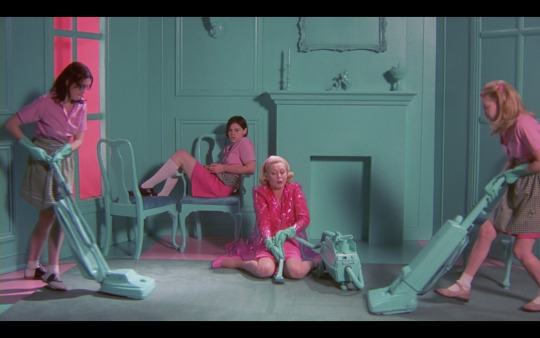

When it comes down to it, But I’m a Cheerleader has heart, and it has a great message. It is immensely funny, and the characters are shallow but lovable. The film’s best attribute is that it shows that anyone can be gay or straight, regardless of our assumptions based on how well they perform gender norms. The criticism shown above should not discourage anyone from watching the film. Rather, it should encourage people to watch it while being able to recognize and accept the ways in which it can be hurtful. It can have harmful stereotypes, unhelpful ideologies, and tactless jokes, but it also has love, bite, and an abundance of humor.
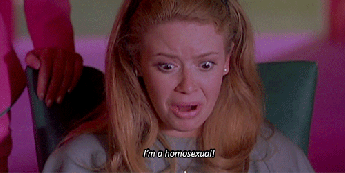
References:
Cavalcante, A. (2017). Breaking Into Transgender Life: Transgender Audiences' Experiences With “First of Its Kind” Visibility in Popular Media. Communication, Culture & Critique, 10(3), 538-555. doi:10.1111/cccr.12165
Dixon, W. W. (2015). An Interview With Jamie Babbit. Post Script, 34(2).
Duggan, L. (2003). Equality, Inc. In The Twilight of Equality? Neoliberism, Cultural Politics and the Attack on Democracy (pp. 43-66). Boston: Beacon Press.
Harris, A., & Holman Jones, S. (2017). Feeling Fear, Feeling Queer: The Peril and Potential of Queer Terror. Qualitative Inquiry, 23(7), 561-568. doi:10.1177/1077800417718304
#QueerMedia#intersectionality#homonormativity#breakout text#But I'm a Cheerleader#Natasha Lyonne#Dante Basco#homophobia#conversion therapy#camp
27 notes
·
View notes
Link
Face it, the mainstream media is not only full of contradictions, but deep-seated, institutionalized biases. When a male or conservative does something, it is often considered horrendous. Yet when a female, liberal or a member of another “special” group does the same thing, passes are given or journalists’ eyes are averted.
Social media users with common sense political opinions have already started to compile these glaring double standards. Return Of Kings and its supporters should continue doing the same thing.
So here are five of the most egregious recent examples of hypocritical mainstream media madness:
1. Use of dead veterans’ families at political rallies or conventions
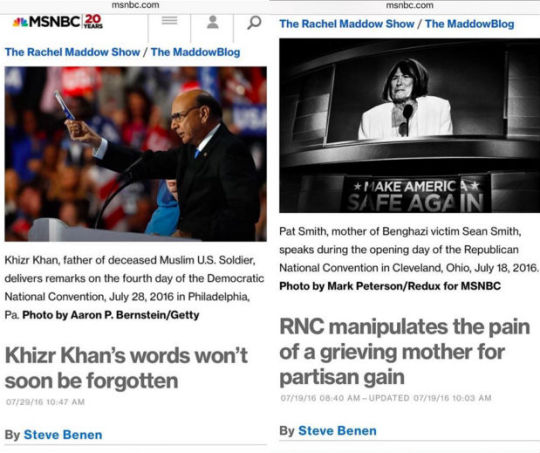
When Khizr and Ghazala Khan appeared at the Democratic National Convention to lambaste Donald Trump for his views on Muslim immigration and supposed behavior, commentators and journalists went wild with fanfare. Their son Humayun, a Muslim soldier, had died in Iraq. Trump was attacked for allegedly grandstanding about and minimizing Humayun’s death.
Meanwhile, many of these same newsmen and women, including Rachel Maddow’s stooge Steve Benen, derided the Republicans for featuring Pat Smith, mother of Benghazi fatality Sean Smith, as a speaker at their own Convention. Mrs. Smith had laid into Hillary Clinton over the latter’s role in and perceived indifference to her son’s death in Libya. So one family became heroes to the media for going public after their tragic loss, while another was portrayed as so weak in their grief that they were manipulated by big, bad Republicans into talking.
Moreover, Trump had nothing to do with Sean Smith’s death. Compare this to Clinton, who was the Secretary of State at the time of the American deaths at Benghazi and whose State Department had received numerous calls for assistance. Considering that Sean Smith and others died alongside U.S. Ambassador Christopher Stevens, the first American ambassador to be killed whilst serving since 1979, the woefully insufficient security precautions taken by the Obama Administration and Secretary Clinton should not have transpired. But this spotlight on Clinton does not make for good (liberal) news.
2. Psychiatric records for a war hero vs. medical records of a pathological liar
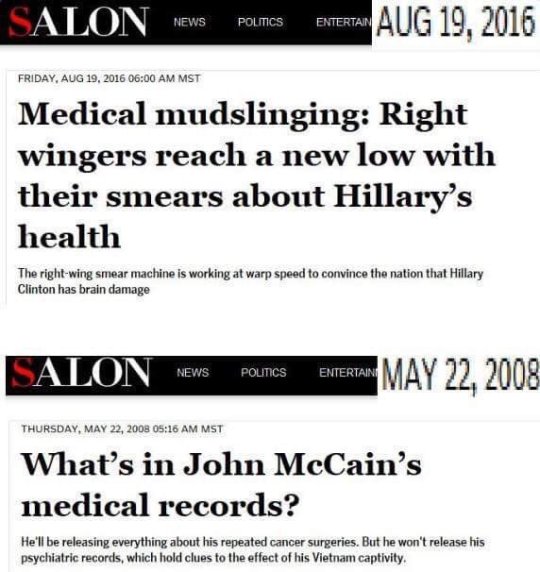
Countless liberals, both in the media and within other leftist cabals like mainstream Hollywood, have attacked those questioning Hillary Clinton’s health as “misogynists,” “sexists” and other undesirables. When these tags are unable to be used, leftists claim that even piecemeal doubts about her physical condition are nothing but conspiracy theories on par with Roswell UFOs and lizard people running the world.
Yet eight years ago, these same people were frothing at the bit to out John McCain for his supposedly poor health. Most perversely of all, they homed in on his decorated military service, suggesting he had Presidentially disqualifying mental health conditions from his service in the Vietnam War and the multiple years he spent as a prisoner-of-war. “Where are his psychiatric records?” bellowed one piece from Salon, in addition to a number of other articles that more than hinted at the same topic.
Whilst I, like many of you, revile his putrid, watered-down “Republican” policies on many issues, McCain had gargantuan balls in Vietnam. Here is a man who spent more time as a tortured prisoner-of-war, including a stay in the notorious Hanoi Hilton, than Barack Obama spent in the US Senate. As the son of the commander of US forces in Vietnam, McCain received numerous offers of repatriation from the North Vietnamese. He refused and would only accept being returned home once fellow American soldiers captured before him were released. By contrast, Hillary lacks the mental fortitude to tell the truth most of the time, not even after she’s had seizures, coughing fits, and dramatic collapses on camera!
3. Sexualizing political candidates (and removing their genitals)
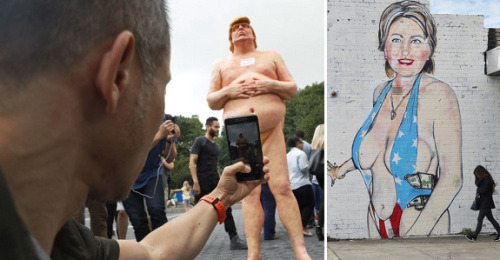
When an artist by the name of Lushsux painted a mural of a scantily-clad Hillary Clinton, a local Melbourne, Australia council and numerous global commentators derided it as “misogyny” and “sexual objectification.” “Take female politicians seriously!” was the crux of their shrill arguments against the rendering. Lushsux then trolled his critics by repainting the mural so Hillary was dressed in an Islamic burqa. Soon after, multiple statues of a nude and testicle-less Donald Trump appeared in American cities. Unlike the Hillary artwork, the proliferation created huge fanfare and delight amongst both prominent leftists and run-of-the-mill liberal voters. Why is one act so offensive and the other so funny, particularly in age where body-shaming and mocking someone’s appearance is meant to be so taboo?
Most of the critical commentaries about the Trump statues that appeared in the mainstream media, of which there were few, failed to take into account one glaring significance of the testicle-less Trump. Short of them being violently taken or hacked off, how exactly could Trump have no balls? Imagine the furore if a statue, mural or other representation of Hillary Clinton had lacked breasts or shown her vagina circumcised/mutilated. “They’re condoning violence against women!” would be the stock-standard answer from liberals and their even more deranged SJW cousins.
4. Lesbian’s Olympic marriage proposal vs. heterosexual male’s Olympic marriage proposal
This is bad and misogynistic:
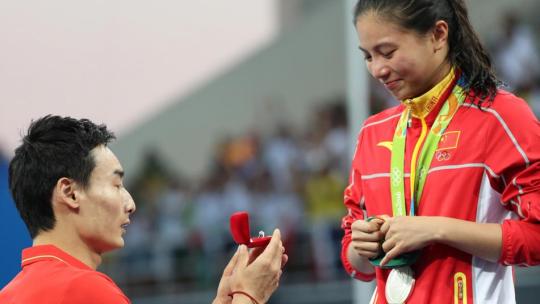
This is love and should be applauded:

Leftists rejoiced when Olympic official Marjorie Enya asked her partner, rugby sevens player Isadora Cerullo, to marry her using a microphone. Love wins, right, especially when it’s gay love? But when Chinese athlete Qin Kai asked silver medalist He Zi to marry him, the knives from the British Broadcasting Corporation (BBC) came out. The BBC, unfortunately taxpayer-funded, published an article insinuating that Qin Kai was attempting to control He Zi with the very public marriage proposal. Not only could it be control, it could be awfully pernicious “male control.” Coverage of Enya’s proposal to Cerullo, however, got the broadcaster’s tick of approval.
If either of the two proposals is a form of control or narcissistic, it was the lesbian one. Unlike the Chinese diver, who was competing individually, the lesbian proposed to was part of the Brazilian team, which had not even been awarded a medal. Brazil had come ninth and that night Australia had beaten New Zealand for the gold medal. He Zi may not have won the gold medal, but she had actually participated in the final. But do not let facts get in the way of a good male-bashing.
5. Objectifying men vs. objectifying women
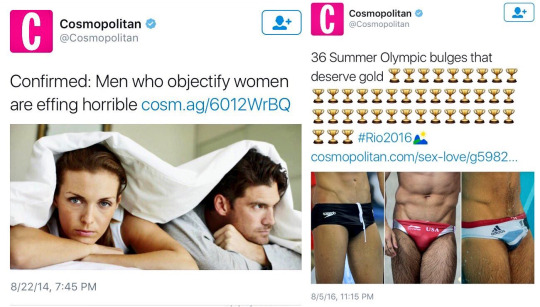
Cosmopolitan has established itself as a dual enabler of both ditzy female airheads and SJW political freaks. Over time, the magazine has come out strongly against countless normal displays of male sexuality, admonishing men who appreciate female breasts and buttocks for being “horrible.” Of the many Cosmopolitan pieces to take this line, an article in mid-2014 takes the cake for its ridiculous shaming of harmless, healthy behaviors. Ironically, though, covers for this publication feature the same sorts of thin, healthy women that men desire most in the first place.
Fast-forward a mere two years and Cosmopolitan went to the extraordinary effort of cataloguing 36 men whose crotch bulges tickled their fancy. Of course, numerous other articles during that time had objectified men in a way considered misogynistic when males do it to women, but the timing was amusing. After so much talk of valuing female athletes, whose physical accomplishments are far less than men, for their work and not their bodies, Cosmopolitan celebrated the years of sacrifice of male athletes by effectively taking photos of their barely clothed genitalia.
We could keep on going
Many other hypocritical pieces were penned about these situations, not just the ones I have referenced. Then there’s the great number of other articles we could assess and critique on separate issues. You may be convinced, and rightfully so, that the mainstream media is inherently biased. But we need to take this to the next level and disseminate the proof to wider audiences.
Journalists and commentators will continue their bad habits, that much is clear. What matters now is fighting back. Complaining about double standards only goes so far. Exposing them in an organized fashion stands a better much chance in helping us to arrest and then reverse this institutional bias.
As Return Of Kings readers, you are our extra eyes and ears. If you find more examples of extreme leftist media bias, bring it to our attention.
https://www.returnofkings.com/19995/anti-female-stem-bias-a-bayesian-explanation
The New York Times recently ran a long piece exploring the history of women in STEM fields and attempting to explain the ever-present difference between men and women in performance and participation in these fields. The article begins by citing research on perceptions of female aptitude in math and science:
��Researchers at Yale published a study proving that physicists, chemists and biologists are likely to view a young male scientist more favorably than a woman with the same qualifications. Presented with identical summaries of the accomplishments of two imaginary applicants, professors at six major research institutions were significantly more willing to offer the man a job. “
She shares an anecdote that is supposed to display the prejudice of professors against females in the field, but instead illustrates one valid reason for the bias displayed by the Yale study:
“Other women chimed in to say that their teachers were the ones who teased them the most. In one physics class, the teacher announced that the boys would be graded on the “boy curve,” while the one girl would be graded on the “girl curve”; when asked why, the teacher explained that he couldn’t reasonably expect a girl to compete in physics on equal terms with boys.”
Enter Bayes’ Theorem
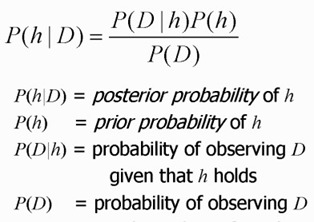
Bayes’s theorem is a foundational principle of statistics and probability that allows us to update our estimations about the trueness of a fact based on new evidence. The math of Bayes’ theorem is simple and elegant, and the overarching idea is powerful — we can use evidence in a formalized manner to change the probability that something may be true, and this can often have non-intuitive results.
The classic example of Bayes in action is medical tests — for example, if 1% of women have breast cancer, and a mammogram detects the cancer 80% of the time with a 10% false positive rate, what is the probability that a positive result means the woman has cancer? If a mammogram is positive, the chance of cancer is less than 8% due to the presence of false positives, as well as the low baseline population rate of cancer.
What does this have to do with women and STEM fields? Readers of this site are familiar with the allure that even a plain looking girl can have at the height of her availability and youth. This isn’t just a factor when getting free drinks at the bar – it extends to the classroom, hiring for jobs, treatment in everyday life, and many other areas. Girls in primary and secondary school are judged to be better students, despite boys showing a significant advantage in standardized tests starting around middle school. The article highlights the ways that women are supposedly discouraged by the system, but makes no mention of the advantages they enjoy.
Put simply, women are more likely to be handed accomplishments without having to work for them, both due to the power of their sexuality and as unconscious overcorrection for their supposed disadvantages in opportunity. Given an applicant with a certain pedigree – a Ph.D, say, from a top graduate program —we will have a certain estimation of that person’s intelligence and aptitude. However, the “false positive” rate on those qualifications identifying extremely high aptitude is likely to be much lower for a man, who has not enjoyed the advantages of a feminized education system, catch-up programs, and the hint of his sexuality influencing the evaluations of his superiors.
The bias against hiring a woman whose qualifications are equal to a man, and their subsequent lower salary offer, is simply a use of Bayesian inference. It accounts for the implicit probability that the female will not be as good as her résumé suggests, to say nothing of the chance that she will leave her job to begin a family and leave her employer empty-handed at some point in the future. If, as the example above states, both men and women implicitly behave as if men are superior in math and science, we must give some consideration that this is a possibility.
If Men Are Better At Math/Science — What’s The Big Deal?
The media is encouraged to sing the praises of women where they excel compared to men, and females indeed show demonstrated advantages in many cognitive areas. They are better at language acquisition, picking up on non-verbal cues, and we are all familiar with their evolved capacity for psychological manipulation. Many would suggest that women have better organizational skills. They are incarcerated for violent crimes less often, are less prone to risky behavior, and are more resilient to psychological trauma such as PTSD.
But when it comes to exploring why men have long-demonstrated advantages in certain disciplines, the media scrabbles to ascribe the boogeyman of injustice perpetrated on the protected class. The article is quick to dismiss the repeatable and longitudinal difference between males in females in standardized testing, a long-standing form of evaluation that every college and grad school uses to give out valuable admissions spots. It also does not mention the lack of female representation in technology entrepreneurship, a field that is less dependent on credentials and more on individual drive, creativity, and aptitude.
It could certainly be true that women are discriminated against AND that they are simply less common at the far right of the aptitude bell curve necessary for competitive positions in academia. But I challenge you to find this idea entertained in any mainstream publication despite the mountains of circumstantial evidence. Larry Summers was tarred and feathered for even mentioning research on population dynamics as a potential driver of this difference. The lesson here is that, when you begin an “inquiry” by presupposing the conclusion, you will end up with a politically correct and eminently intellectually dishonest worldview.
Read More: The Anti-Male Commercial
4 notes
·
View notes
Photo
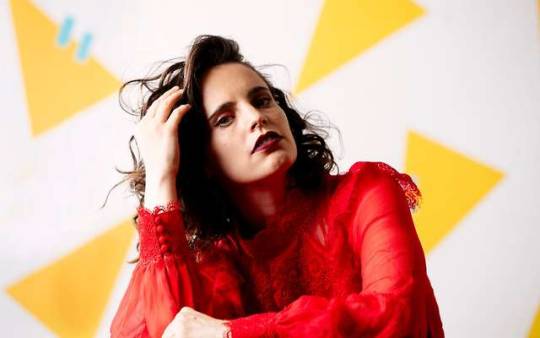
ANNA CALVI INTERVIEW: ‘Rock ‘n’ roll isn’t over – male rockers are’ - 12.08.2018
DAILY TELEGRAPH - Text By Neil McCormick - Photos by Rii Schroer
Five years after the 37-year-old British singer-songwriter’s second album of noirish art rock earned her a second successive Mercury Prize nomination, Anna Calvi is back with a third album.“I have long felt frustrated at the limitations of what a woman is allowed to be, on a very basic level,” says Calvi.
“Perfect, smiling, accommodating. Why do I have to live up to these ideals because of my anatomy?” Fierce and sensual, timely in its grappling with gender stereotypes and female visibility, it is her most striking work to date. She called it Hunter, she tells me, because “I like the idea of a woman going into the world and just taking what she wants”.
The evening before we meet, Calvi is onstage in the West End nightclub Heaven, dressed in a black designer suit, wielding a red Stratocaster guitar, goading and provoking the audience.She sinks to her knees as she plays, then on to her back, abandoning herself to the strange sounds erupting from her instrument.Anna Calvi: ‘It just has to come out like this hurricane’
During a virtuoso rendition of gender-bending anthem Don’t Beat the Girl Out of My Boy, she releases an operatic wail that convulses her whole body. It is the mesmerising, powerful performance of a woman in her rock’n’roll element.
The next day, in the shabby south London offices of independent record company Domino, Calvi seems an entirely different creature: petite, demure and self-contained. Her speaking voice is high and soft. “I was very quiet as a child,” she says “and I really liked that the guitar could be my voice instead of me.”
When I ask if her raucous performance style has helped banish her essential shyness, she laughs. “I’ve been waiting for years for that to happen,” she says. “But maybe that’s a good thing. Being introverted means that you have all this energy that’s building and building, like it’s a ball of fire and you don’t know how to release it. Then it just has to come out like this hurricane. For me, that is what being creative is.”
Calvi was obsessed with music from a very young age, yet struggled to identify any female role models. “If you are a woman wanting to find yourself in music, you have to project yourself on to the male story,” she says. “It’s the same for films, books, art, the same for any kind of culture. Women have been made invisible.”
While writing her latest set of songs, Calvi imagined that her listener was her younger self, being confronted “with a more realistic depiction of the multifaceted woman, the animalistic, primal woman, the messy woman, the queer woman, the woman seeking pleasure without any shame.”
Calvi talks quietly but passionately, in long, carefully articulated sentences. She says that the period since her last album – One Breath, in 2013 – involved a lengthy process of self-examination. “So much of our gender is performed, I feel, it’s very limiting for both sexes,” she says. “As a woman, you’re made to feel your appearance is what you are. It’s what you look like [that counts] and not what you do.
“And for men, to always be strong, to not be vulnerable or show emotions or talk about how you feel, is such an unrealistic expectation of a human being. It’s literally the opposite of what being human is.”
Calvi’s self-titled 2011 debut contained a track titled I’ll Be Your Man. Her new album opens with As a Man, in which she sings “If I was a man in all but my body/ Oh would I now understand you completely?/ If I was walking and talking as a man.”
“I never felt completely comfortable with being a girl,” she admits. “I found puberty really hard, having a woman’s body suddenly impose itself. As I grew up I came to accept it – I don’t feel trans – but at different times I feel more masculine or more feminine. My sense of identity is quite fluid. Maybe the answer is just not to have labels.”
Calvi was born in Twickenham, to an English mother and Italian father, both of whom are therapists. Her first instrument was violin, and she graduated in 2003 from the University of Southampton with a degree in music. Her inner rocker, though, had been unleashed years earlier when, at the age of eight, she saw footage of Jimi Hendrix at Woodstock, giving a performance that just “looked and sounded like freedom”. She also cites the Belgian-born jazz composer Django Reinhardt – “who taught me about arpeggios” – and West African music, “which taught me about sweet picking”.
Anna Calvi: 'Maybe the answer is just not to have labels.’
Until recently, there have been few prominent female guitarists in popular music, something Calvi blames on cultural stereotypes. “I don’t think the guitar is a gendered instrument,” she says. “It’s like cooking – it’s about taste. It’s not like you need giant muscles to whip an egg.” Indeed, she goes so far as to propose that the future of rock will be female. “There is all this talk about the death of rock and the end of the guitar. What I think is dead is this kind of very one-toned thing of straight white men in bands singing about f—ing girls. “A lot of the guitarists making waves now are female and that may be partly because there isn’t a history of the female guitar hero, so there is something fresh that twists and subverts the story. I like to see women playing guitar. Courtney Barnett and St Vincent are doing really interesting things.”
The real watershed moment will only come, she says, “when we don’t use the term ‘female artist’ anymore. Because women are a gender, they’re not a genre.”
In pop terms, Calvi was a late developer – she didn’t release a solo record until her 30s. She had “a phobia” about her voice and didn’t sing at all until her 20s when a fascination with Maria Callas helped her to develop a powerful, almost operatic, range. “Now, my guitar and my voice both speak for me, and on Hunter they are trying to express a sense of freedom and wildness and something visceral, this idea of breaking through any kind of restraint.”
At school, she wondered whether she was gay, but thought perhaps her feelings related to “having no boys around”. Then, at university in Southampton she had “a few boyfriends” followed by her “first experience with a woman”. It was a confusing time. “We were literally the only queer people that I had ever seen, just me and my partner in the whole college, that was it. I wish I could have experienced those feelings without questioning what it means. And worrying that it [was] wrong, and feeling shame, and dealing with all these external forces that aren’t actually to do with the relationship.”
She has never hidden her sexuality but admits to “feeling nervous” before her first album came out. “I felt it was incredibly queer and I just didn’t want to be defined in that way. But to my surprise, no one seemed to pick up that all my songs were about women.”
One Breath was written just as an eight-year relationship was coming to an end. “I was hiding behind the lyrics a little, I didn’t want to talk about our break-up, which isn’t really the best thing when you are trying to write songs. But this time I was like: have it all!”
While working on Hunter, Calvi began a new relationship with a French woman, living in Paris and Strasbourg. (They are now in Clapham, south London.) “It was a new beginning, in all kinds of ways. After a really long relationship, you have to kind of rebuild yourself. The music came through that.”
The album is peppered with images of Eden and Paradise. “I was trying to find a way of being happy after a trauma,” says Calvi. “Eden represents the idea of utopian love.” She laughs, as if she finds this thought inherently ridiculous. “In a way, belief in love is belief in God. It’s very optimistic to imagine that somebody can save you from yourself, but we all believe it and I find that tragically beautiful, because I believe it too. When I see my girlfriend, just seeing her makes me feel more hopeful about things, but the truth is, everything gets worse and we die.”
Calvi’s best songs strike an unusual balance between opposing qualities, plucking something life-affirming out of cynicism, nihilism and fatalism. Those opposites are also evident in Calvi herself; so quiet and intense offstage, so wild and free onstage.
“Maybe this is a bit fatalistic but I always think ‘if this is the last thing I ever do, the last record I ever make, the last performance I ever play, how do I want to go out? How do I want to leave it?’” she says. “There is a bit in Don’t Beat the Girl Out of My Boy that I have to sing very high and very loud and I can’t do that without completely surrendering myself, where there is absolutely no space left to think or be anything other than that note.
“And that is what I want music to be. It is really liberating and exhausting. And a bit worrying. After I sang it the first time, I thought, ‘S—, now I have to do that every night. What will be left of my body and mind by the end of this?’”
9 notes
·
View notes
Text
Ever Since I Can Remember
I have been surrounded by ridiculously independent, confident women. My mother was/is a chemist, my grandmother’s took charge of their households, my aunts are all working jobs that they love while simultaneously raising children. My research bosses are both women, my managers at Disney were often women, my economics professor (and hopefully future mentor) is a woman and so many of my favorite language professors were women. It’s easy to see why I am the way I am haha. I truly believe that these women have shaped me in immeasurable ways across all aspect of life. However, when I found Second Sex by Simone De Beauvoir on our bookshelf, I was a little bit intimidated to learn what my fate would be as a woman but let me tell you I was not disappointed.
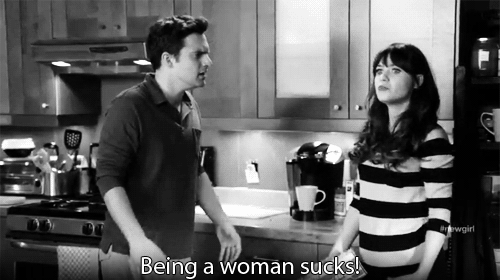
Second Sex was written in the 1950s by feminist Simone De Beauvoir in France. It was roughly translated into English and is commonly referred to as required reading in both women studies and existentialism courses. The topics discussed follow womanhood through Destiny (biology), History, Myths, The Formative Years, Situation, Justifications, and Liberations.
The Destiny section, in my humble opinion, was the most boring (although still necessary). It essentially delves into the differentiations between the male and female sex biologically as well as how these biological factors are often apparent in animals as well. I was very pleased with her writing because she truly did not sugar coat anything at all and her opinions were very minimal in comparison to fact. In that regard, De Beauvoir compares the obligations of the male and female in terms of perpetuating a species. As i’m sure you’ve all learned in an intro either history or biology class, the intents and purpose of the male are to protect while the purpose of the female is to maintain. The female is the passive vessel and the man is the active instigator. That’s just how it is. I found it interesting that she discusses that it was actually commonly believed that the male had less of an active role in sexual reproduction than we know now, meaning that many people thought the sperm weren’t even necessary for reproduction. Anyyyway,
Historically accepted, these biological responsibilities contributed to what we’ve studied as the hunter-gatherer societies. It’s a biologically known fact that a higher percentage of a man’s body weight is attributed to muscle mass, therefore they were always out hunting. Women, on the other hand were left to their own devices at home. In fact, we know that the sole purpose of the woman at the time was to be a distraction for her husband. Her kids were often encouraged to “grow up” and “help out” but she was often doomed to a sedentary life. Not only that, but the nomads of patriarchal societies very seriously viewed women as sexual objects of pleasure, always giving and never taking. That’s why polyamorous relations were so common. They had no right to argue against at that point. There were some societies however, that had different views. In matriarchal societies the woman’s running of the household was more highly respected. The reasoning for this bleeds into the Myths section of the book.
Since ancient civilizations and the creation of the domestic community, both myth and religion have attributed the characteristics of the woman to that of nature. A theme commonly referred back to in this book is that woman is immanence while man is transcendence. This means that the woman represents “the divine” she is nature and the uncontrollable. This is an interesting view because as a pipeline debate, this has been seen as both a good and bad thing. The woman can represent beauty in the form of mother nature, or inherent evil if she is left to her own devices, and will therefore resort to black magic and witchcraft. It’s kind of like...wait what? But at the time it made sense. Males, on the other-hand transcend the universe. They operate entirely outside of what is natural. If you think about it, in school we always talk about how the creation of the first tools of cavemen were so important because they represented a control over that which was previously unable to be controlled. In essence, that is what the man represents. The ability to lasso and reign the chaos of the universe. Woman, contrastingly, IS that chaos. She is emotional and flighty and confused. She doesn’t know if she should be proud of her womanhood or ashamed and that is all due to the psychology of the formative years.
As a young girl, and I’ll be pretty blunt here, there is psychological debate about the concept of penis envy. What this means is that at a young age a young girl may see her brother..I don’t know...peeing in the woods or something and think “wait, why can’t I do that” and this is often subconscious in the sense that there is known to be internal dread and shame associated with not being able to see and control female genitalia as easily as males can. Along with this, puberty is like a slap in the face. We’re (females) are always encouraged and supported in “becoming a woman” but it’s a horribly inconvenient process. In fact, De Beauvoir even concludes that this stigma in a girl getting her period for the first time often leads to an inferiority complex because for the first time she tangibly recognizes her societal insubordination and passivity. Pessimistically said, she realizes that she will be a prisoner to her body for the rest of her life (yay!) This kind of confusion continues into adolescence where the entirety of a girls life (most of the time, not all of the time..of course there are exceptions) is spent thinking about catching the attention of some guy. This is ingrained in us whether we like it or not and god FORBID you grow too old for a guy to be attracted to you anymore before you get married..it’ll be seen as you abandoning your life’s purpose.
There’s a section about sexual initiation that honestly made me a little bit sad. Mainly because it really drilled home the concept of passivity. There used to be such a huge stigma about sex and what it represents and a lot of that was often biologically incorrect anyway. For example, historically, if you have sex and a woman’s hymen breaks it means she was previously a virgin and there should be blood to prove this case. However, it’s been widely known in recent years that some women don’t even have a hymen or it broke doing some sort of remedial task like riding a bike and they don’t even realize it. In simple terms, it’s really not that deep haha. In some cultures, it can be though. There are cultures that actually PREFER that a woman has had sex multiple times before she gets married because it means that the husband will have a more enjoyable time with someone who is experienced rather than having to carefully operate.
The stigma of the virgin was a big thing too. Naturally, this has a lot to do with religious preferences (but I guess in their eyes it’s obligation) to remain chaste until your wedding night. Personally, (not always) I think this can be a toxic mindset. When sex is viewed on a pedestal, a lot of women are unfamiliar with their bodies and often become frigid and afraid of having sex for the first time. And if I know anything it’s that in life there are so many times where body and mind operate in tandem. If you are afraid of something that you’re naturally created to do then there is a higher chance of your body rebelling against you (I should know lmao).
Simone also talks about sexual preference, because even in the FIFTIES they knew that sex and gender and sexual preferences were all different things *ahem*. Anyway, a man is often viewed as superior due to their virile temperaments, which if you don’t know, means that they naturally are stronger, have more energy, and have a more dominate and regular sex drive. These are all things that very clearly are not biological in my eyes, meaning that women can adopt this temperament as well in the form of being more energetic and a more dominate and strong personality which often leads to becoming a lesbian. I don’t want to be too detailed about this topic because I don’t want to say anything ignorant, but a lot of it is related to how you were reared as a child. Determinants include either having a positive or negative relationships with your mother, having deep relationships with women mentors etc etc. She makes the claim that the opposite is true of homosexual men. There’s a lot going on there. I was pleased to see, however, that again, she was very factual and it was surprising to me that she did not exert as much of an opinion as I would have thought. She did, however, claim that sexual preference was a choice and in that regard I disagree. While temperament is SWAYED by environment, it is not entirely determined by such. In every scientific/psychological etc debate, nature and nurture are coexistent. You can’t pick and choose when that’s true and when it’s not.
I could easily go on and on and on about this book. She talks about the origins of prostitution and what it means to be a mother and what happens to women when they mature etc, BUT, I must narrow the rest down because I’m getting tired :)
A very interesting point to me was the concept of ego and narcissism in terms of romantic relationships. She says that in (heterosexual) relationships, the man is often looking to condition and mirror/ learn more about himself through the woman while the woman was subconsciously looking to validate herself through the affections of the man. Damn, that’s definitely a statement. I’ll be honest I was a little bit pissed because it felt like she was saying we have no coherent thoughts of our own when in reality what she was saying was that this is what the sexes are CONDITIONED for, and in every relationship I’m sure there is an ounce of truth to this. However, she also said that it’s important to adopt both tendencies if you want a functioning relationship. By this she means that the male, while recognizing the femininity of the woman must also allow her to become independent and transcend. She must be able to learn just as much about herself through her relationship with him as he does with her. In the same way, guys want to be validated too. For a lot of them, if they’re sincere and genuine then the validation of their lover or wife or whatever would be enough. That represents a sense of maturity that a lot of guys don’t have (that’s why their relationships don’t work).
A big part of maintaining a relationship, in tandem with maturity levels, seem to be a sense of obligation. It’s likely that sex drive will die down and as the bodies of individuals deteriorate there are other things that keep couples together. Obviously it’s scary thinking about losing the novelty in a relationship and having someone get bored of you, but optimistically every day is a new day and if you’re going through it with someone you truly love then you shouldn’t get bored. In fact, the mundaneness of everyday life often brings people closer in the weirdest ways.
I skipped a lot, but the last section is about a woman’s liberation. It’s about the balance between accepting her femininity and bracing a man’s world. It’s about being prepared to not be taken seriously, to be ignored, to constantly have to prove her worth in the business world. Again, I love how blunt Simone is. She really says that there is cause and reason for societal change, but don’t be naive...and she was so right. Considering the fact that it has been 70 years since this book was written and so many of her points still hold true is proof enough of her pragmatic way of analyzing the world. She said that it would be difficult for the intellectual woman to succeed because she would constantly be at odds between her goals and her womanly obligations.
This sentiment bummed me out a little bit but when I read it again I realized that while she said it would be difficult, she never said it would be impossible ;)
-Julia
0 notes
Text
If you have been following my blog for a while, you probably know that despite being an avid fantasy and romance genre lover, I really enjoy both genre fiction as well as non fiction with strong political themes. And politics for me includes a broad spectrum like actual electoral politics, civil rights and discrimination of marginalized groups, feminism and other gender related topics, the effects of capitalism and corporations – basically anything that affects the lives of individual people or the country as a whole in both the short term as well as the long term. I also really love it when genre books include such important themes but as metaphors to the real world, giving us the opportunity to escape to new worlds but also engage with real life issues.
As such, I have a bunch of books in various genres that I would love to recommend and hope that you’ll enjoy them too.

Fiction
I think it’s not a surprise that Red, White and Royal Blue is at the top of the list. It doesn’t mean that I think it’s the best or anything, it just happens to be my favorite. And I loved how it explored so many themes like election campaigns and how they don’t always work the way we think they do, the unique struggles of a female presidential candidate (which we have also been living since 2016) and what happens when you add biracial children and homophobia to the mix, and also the importance of having an accepting and supporting family.
I’m a huge fan of anthologies and A People’s Future of the United States is one of my favorites. It’s full of speculative fiction stories about all the different paths our country might take in the future, and how there are always going to be people who will fight for the rights of those who are being oppressed. It’s powerful, thought provoking and hopeful, and I hope you all will give it a chance.
Take the Mic is another favorite anthology of mine but this is about youngsters in our world trying to fight both personal and macro level oppressions through resistance everyday in whatever little way they can.
The Test is a novella which is just around 100 pages but the way it handles the topics of immigration, citizenship and xenophobia and makes us question our own humanity is a complete mindfuck and the author is a master storyteller.
I love books that talk about feminism in any genre and I thought Watch Us Rise has excellent commentary on intersectional feminism as well as body shaming from the perspective of teenage girls and though it could be a bit high handed at times, I really enjoyed this book.
We Set the Dark on Fire is one of my favorite YA fantasies and the way it handles themes like illegal immigration, the refugee crisis, and inane concept of a border wall is excellent and very relatable to our own real world situations.
This may just feel like a romance novel (which it is and a wonderful one at that), but it explores the much relevant theme of racial profiling of Black people by the police in our country (and discrimination of black and brown people in general) and even though it’s a topic we all are quite aware of, the way author writes it just hits you hard. There’s one particular scene that is especially harrowing and I don’t think I’ll ever forget that. Definitely recommend this one for all romance genre fans.

Non Fiction
Drift is actually a pretty old book which I read a few years ago, but I have a feeling that the topic it deals with – military industrial complex, the bloated budget of the Pentagon and the never ending wars – are still relevant today and it was very eye opening for me.
Blowout on the other hand is about the Oil and Gas industry across the globe and the way this industry has destroyed the lives of millions of people, often with the full support of politicians and governments. This is an expansive book about what happens when unchecked greed in a highly unregulated industry runs rampant and I would highly recommend the audiobook.
In Why? Explaining the Holocaust, the author goes back a long way in history to trace back the origins of the hatred towards the Jews as a people, all the other groups like the Catholic Church that fanned the flame and how it ultimately culminated in Hitler and the Holocaust. This book is a very informative and thoroughly researched work and I would definitely recommend if you are interested in the topic.
The Retreat of Western Liberalism was probably one of the first non fiction books I read after the 2016 election and it talks about the fall of liberalism as an ideology and the rise of far-right groups across the globe, and the author also gives some scary scenarios of what might happen in the US as well. It’s an important cautionary tale and while it may feel a bit dated now (a lot has happened in the last three years), I still think parts of it are relevant and worth giving it a try.
This is a very inspiring and hopeful collection of essays by ten young women who got the opportunity to work in the Obama White House and they talk a lot about what others who are interested in public service can do and what kind of jobs are done daily by the President’s staff. It’s not always as glamorous as shown in TV but it’s very important work and I loved reading this book.
The first reaction any woman reading Invisible Women will have is anger and exasperation. Anger that sexism has permeated every aspect of society in such deep rooted ways that it’s difficult to even think about how to solve the issues the book talks about; exasperation because even in 2020, we are still second class citizens in many ways we don’t even realize. I don’t wanna give any details but if there’s one book I will highly recommend this Women’s History Month, it is going to be this one. Just pick it up and be ready for your mind to be blown by the unfairness of it all.
You might be wondering why Burn it Down, a book about women’s anger is political but I believe that historically women have been discouraged from using anger as an effective emotion to express themselves and act of trying to reclaim that anger now is inherently political. This is a collection of essays by authors about how they have used the anger they feel in other productive ways and I promise you, it’s very very relatable. And I think the topic is currently highly relevant because the female candidates for President are always questioned why they are shouting or being shrill or angry, while a male candidate behaving the exact same way never gets any criticism.
Both She Said and Catch and Kill are about the countless women who were sexually harassed and raped by Harvey Weinstein for a number of decades and getting away with it through money, power and intimidation tactics. But other than this particular case, the books also give a glaring look into how men in power use all the money and resources available to them to do whatever they want, and how other people in power aid them to succeed in this harassing behaviour and cover up. They are hard to read, but are amazingly written and are a testament to the courageous survivors who finally decided to speak up and share their traumatic stories. Highly recommend and very relevant after the sentencing he received in New York just about ten days ago and more probable cases being filed in California soon.
Finally, my last recommendation is a history book but please don’t discount it as boring. When we think of colonialism or imperialism, the countries that come to mind are usually Britain, Spain or other European nations – but we never think of America in the same vein. In How to Hide an Empire, the author reveals the duplicity of our country’s politicians in spouting anti-imperialist platitudes in public while actually occupying many countries and oppressing the colonies in horrible ways – and this is a book that traces the history of American colonies from the 19th century till the present day. This is an eye opening read and something I believe everyone should read just to get an idea of our own country’s often forgotten history.

Have you already read any of these books? What did you think of them? Have I convinced you to pick any of these? Let me know which of these books interest you the most and why in the comments below….
Book Recs: Books with Political Themes If you have been following my blog for a while, you probably know that despite being an avid fantasy and romance genre lover, I really enjoy both genre fiction as well as non fiction with strong political themes.
0 notes
Text
since apparently theres no consequences for delivering unto this website extremely long and good takes i will present to you my hot take on the ace d'escourse, with no sources because I Dont Feel Like It. its more words than is reasonable bc i have been stewing in this for like 4 years and if i dont type it out at some point im going to fucking lose it. no, literally, it’s 3 pages long in word about shit no one cares about anymore. please remember to like and subscribe.
some background on me, i id’d as ace for something like 8 years, from the first time i read the wikipedia page on it back in maybe 2009 or thereabouts. i also id’d as aro for about a year in 2016. that is to say, i have a lot of compassion and understanding for asexual individuals and feel i understand the inclusionist side of the argument pretty well, as i never questioned inclusionism until maybe 2014 or so, when the discourse blew up. i took some time off tumblr because i was so fucking distraught to think that, as i id’d as aroace at the time, that i had to come to terms with not being lgbt. lol i was a little too attached to being ‘gay’ because... fun fact, past dumbass self... you are gay. anyway, i really dont want anyone to feel that i hate them, but after i cooled off a little bit i realized that the exclusionist take on asexuality just makes more sense. hopefully i can explain why clearly enough.
i really believe that what is understood as aphobia is 100% of the time simply a manifestation of our culture’s expectations surrounding sexuality. while “expectations surrounding sexuality” as a very broad topic does indeed cover both the lgbt community and people on the ace spectrum, facing these issues does NOT make a person lgbt. i subscribe to the idea that lgbt is for people targeted directly by homophobia and transphobia. ace issues ARE super important to talk about and the whole inclus/exclus nonsense is entirely because this discourse has been put under the wrong category. im aware that probably most people will not care that much about my opinion on the correct framing of asexual activism as i no longer id as ace but i think this is important for everyone. sexual expectations also weigh on straight individuals, especially women, and i’m going to describe a few examples to try to demonstrate why i believe both that it doesn’t make sense to consider asexuality lgbt as well as why it does make sense to frame it as an issue based mainly in misogyny.
call out post for myself, i use reddit, and i think the r/childfree community is a good example of what i think the framing should be like. although it’s acknowledged that not wanting children has larger social consequences for women, both men and women talk about their issues in the forum, including horrific accounts of reproductive coercion and rape, the intersections with race/being lgbt/ageism (although they could do a LOT better with intersectionality, many posters do touch upon it), profoundly cruel comments made by those who have/want children, difficulty finding an understanding relationship partner, discrimination at work, misunderstandings and even hatred from family and acquaintances, discrimination in healthcare, etc.
i think you can tell where i’m going with this. even though being childfree cuts against the expectations for sexuality in most societies, even though it leads to unfair judgment from others, and even though they face discrimination on the basis of the way they express their sexuality, childfree people do NOT frame parenthood/childfreedom as an axis of oppression, nor do they claim that their lack of desire for children makes them lgbt. it’s not even a question if straight childfree people are straight, because duh? nor if the presence of lgbt childfree people makes the whole community fall under the lgbt umbrella, because it obviously doesn’t.
to drive the point home, the reason why this is NOT an axis of oppression is because parents face a ton of issues as well! they also face reproductive coercion as well as judgment over the number of kids they have, constant scrutiny and moralization over every aspect of their parenthood style, judgment based on parents’ age/wealth/sexuality/marital or dating status/race, housing and employment discrimination, especially for mothers, the government hating poor parents and cutting their benefits, and more i’m sure i’m not thinking of. again, this is due to societal expectations of sexuality. to complete the analogy, people who aren’t ace face their own set of challenges and discrimination. part of homophobia/biphobia is tinged with hatred of our sexual attraction; no one except for straight white men is allowed to really express their sexuality without backlash, and even then there is this shame leading to a lack of proper sex ed and horribly unhealthy understandings of sexual attraction in a large portion of the populace. so calling aphobia an axis of oppression is just not right. and in addition, the large proportion of lgbt aces doesn’t make asexuality lgbt, that’s not how groups work.
some more on what i mean by ‘expectations around sexuality’... in terms of my experience in the US, there is some blueprint in many people’s minds of what a person should be like in terms of sexuality, and that is something like “cishet, abled man, who is neither ace nor aro, who gets laid regularly (but not to excess) starting no later than 18 and ending no later than 28 when he settles down with one cishet abled wife, also neither ace nor aro, who has only had sex with up to three committed boyfriends, and they have precisely two children, approximately two years apart in age, whom the parents can financially and emotionally support to the utmost, because they are also moderately to very well off, and the parents work under traditional gender roles to raise their children as conventionally as possible.” and if you deviate from this script in ANY way that’s viewed with moral panic and scrutiny by someone. and the connection to misogyny is that women are seen as sort of the bastions of sexual morality. we are punished especially harshly for nonconformity.
if you’re poor you’re fucked because either you don’t have kids or you can’t send them off to private schools and feed them fancy organic shit. if you’re lgbt or polyamorous or aro or ace? fucked! if you dare to reproduce as a disabled person, and if your disability impacts your parenthood, especially for women, you’re practically crucified even in liberal circles. if you have too few kids or too many (don’t you know only kids turn out weird? / how can you possibly raise 5 children properly?), if you have too much sex or too little, if you split up the work in your relationship not along gender lines, if you do unconventional things in your parenthood, like accept your trans kids or move a lot or any number of other things, the social judgment rains down like the fires of fucking hell. meaning practically no one can escape it!! huge bonus to the screaming crowd with pitchforks if you’re a person of color or a woman, mega ultra bonus to women of color.
but does that make everyone i just talked about lgbt? no! although every single one of the groups i mentioned is tangentially related through this issue, even though all of them face a lot of horrible problems and discrimination, that does not make those issues inherently lgbt. again, they are tangentially related and i could see a good case for solidarity among many of the groups mentioned; all of them are fighting for greater acceptance of different kinds of relationships, greater acceptance of seeking happiness and being who you are rather than pressuring everyone to conform as much as possible to the LifeScript. but all of those groups are equally related to the lgbt community - that is, tangentially only. just as you can be childfree and straight, a stay-at-home dad and straight, a straight woman of color, so too can you be polyamorous and straight, ace and straight, or aro and straight.
that’s it for my main point. ace and aro people? your lives are hard. i’m not going to downplay it in any way because i know there are a lot of people who actually hate your guts. fuck, i’ve seen people full-on shittalk asexuality, in the internet and real life, in the most blatant of ways, so it’s not just something you can necessarily escape by logging off. not as much so for aro people tbh but i predict as much once the Public gets more wind of your existence. i fully believe that you face a higher risk of sexual assault; discrimination in relationships, housing, and the workplace; horrible comments from everyone who thinks their shitty opinion on your sexuality and love life matters; and I believe you that that hurts and is terrible and that you deserve a place to discuss and provide support.
but. those issues are not exclusive to you. they’re not exclusive to lgbt people, or oppressed people, and so those issues don’t and cannot make you lgbt, nor do they make ace/aro vs. allo an axis of oppression. our communities intersect, yes, considerably, but you are not a subset of lgbt. perhaps our rhetoric can help you, but because straight ace and aro people exist you cannot and should not consider yourselves lgb+. i think you understand that the issues you face are a form of oppression, but they are the result of the toxic and misogynistic sex culture in this society, which, yes, targets lgbt people but also, practically everyone, including groups which are definitively absolutely not inherently lgbt, such as parents, gnc straight people, poc, disabled people, the list goes on.
to conclude, what really converted me to being an ace exclusionist was the example of a straight grey or demi ace. how could you possibly argue that someone who falls in love with the opposite gender only, but with more conditions or less frequently than someone not aspec, is lgb+, can call themselves queer, etc.? exactly what material reality does that person share with a gay or bi person? i think that their issues fall in line with aspec community issues but extremely clearly not at all with lgbt ones.
the end but post script since i brought up orientation modifiers: perhaps it isn’t my place to say, but i don’t think that microlabels are very healthy and that it would make more sense for the ace community to work on expanding the idea of what sexuality is than to try to create a label to describe every single person’s experience of their sexuality. not that i think you should necessarily kick grey ace people out of the aspec community or that they’re not valid or whatever, but that perhaps it makes more sense to say that some people experience sexual attraction less frequently, and that’s alright. i don’t know. i spent sophomore year of high school poring over those mogai blogs looking for some new orientation label that would make me go like, oh my god that’s me! and believing that if those labels helped people feel that way they weren’t doing any harm. but what actually finally made me feel like that was expanding my understanding of what attraction is and a better conception of lesbian issues and why i might feel so disconnected from my sexuality and why i might be obsessing over every interaction with a guy looking for signs i was attracted to him but feel super disgusted whenever they exhibited interest in me. i spent so long trying to go like maybe im cupioromantic lithsexual and feeling terrified that that i had such a weird and esoteric sexuality that no one could ever possibly understand enough to be in a relationship with me... like, ok dyke! i know a lot of people have had similar experiences and i don’t think i know a whole ton of people now in college who are still doing that, which makes me think those labels are more harmful than not.
i guess that’s anecdotal but it’s easier for me to believe that a person could cling to those labels due to internalized homophobia than actually have a new form of sexuality heretofore undiscovered throughout all human history, but that’s just me. and so many of them just sound so unhealthy, like dreadsexual. i really wish people would work on expanding what not being asexual can mean and look like and i dont think there would be this drive to create these labels anymore. even demisexual which i think is probably the most mainstream conditional orientation, i think many people who have never heard of it and are perfectly content not to would describe the way they experience sexuality a similar way and just consider it normal. sexual attraction isn’t necessarily having your nethers set aflame upon first making eye contact with someone, it looks different for every person and it’s alright to just be how you are without making it part of your whole identity.
The End II. this is 2,200 words. if you read this far you’re a fucking mad l- *the academy cuts my mic line while looking directly at the camera like in the office*
0 notes